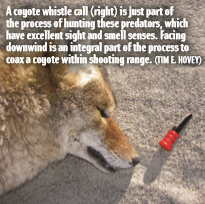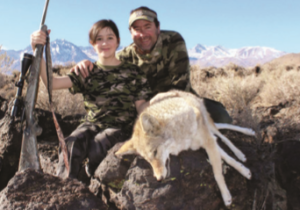COLD-CALLING COYOTES
Winter Means California Predator Hunts
By Tim E. Hovey
When the days start getting shorter and the weather starts to cool, my attention starts to shift to predator hunting.
I’ve been calling predators for over 15 years, and of all the different types of hunting I participate in, predator hunting challenges me the most.
Winter is my favorite time to call predators. The longer nights and cooler temperatures means the animals are more active, needing to feed frequently to stay warm.
Fall into winter is an excellent time to use all types of prey-in-distress sounds, either with a hand call or an electronic caller. I like the ease of using a hand call during the early season. It’s a great opportunity to try out new calls that I’ve collected during the off season.
As with most types of hunting, the more opportunities you’re presented with, the better you’ll get. On an average two-day trip, I’ll make about 20 different stands. On good trips, I’ll get a handful of opportunities to take predators, but, more importantly, I’ll add more data to my extensive predator hunting data set.
Animal behavior, frequent travel corridors, quality stands and sounds that produce responses are all factors I pay attention to and learn from. Just like with any game you chase, the more interactions you experience, the better you’ll know your prey.
REGULATIONS
The California Department of Fish and Wildlife designates predators into nongame mammals (coyote and bobcat) and furbearers (fox). Coyotes are open year-round with no limit. However, many predator hunters participate in a self-imposed season and stop pursuing coyotes from February to September, giving the adults a chance to raise their young unmolested. California has a bobcat season that runs from October 15 until the last day in February. The state also requires a hunter to purchase tags to pursue bobcat. Gray fox season opens up on November 24 and extends to the last day of February as well. Regulations specify that when in pursuit of gray fox, only hand calls can be used; electronic calls of any sort are prohibited.
Specific species regulations and seasons may change from year to year, so make sure you stay updated on the appropriate regulations if you decided to give predator hunting a try.

JESSICA’S FIRST COYOTE
Earlier this year, I took my youngest daughter, Jessica, out for her first real hunt. A few months before, she had passed her hunter’s safety course and wasted no time in asking me to take her hunting. We planned an overnight father/daughter trip in January. The plan was to drive out to the Bishop area, stay the night and then hunt our way home.
That next morning, I found a great-looking spot to start off our day of calling. Two hills created a shallow canyon that emptied out to a flat area and stretched for over a mile. The wind was perfect, and sitting half way up one of the hills would put the sun at our backs.
We quietly hiked to the shady portion of the hill and readied ourselves. I set up Jessica with my Ruger .204 and her shooting sticks. I was shooting my Remington 22-250 as backup. I looked over to Jessica, nodded and told her to stay alert.
I started calling and we both began scanning the area carefully on the lookout for movement. After about two minutes, I spotted a fluffy white object bouncing in and out quickly at 600 yards. I slowly turned to Jessica and told her we had one coming in. I could see she was excited. I had her slowly move her set-up a bit left to intercept the approaching coyote.
The coyote was bounding in as fast as the animal could run. Jessica finally spotted it coming quickly at about 300 yards out. I knew for her to have a chance, this animal needed to slow way down.
Around the 150-yard mark, I dropped the volume on the call. The coyote kept coming but slowed to a quick trot. At 120 yards, I muted the sound from the electronic caller. The instant silence only added to the tension. I quietly asked Jessica if she was on him. “Yes!” she answered. Now 90 yards out, I let out a bark and the coyote slammed on the brakes. He stopped and looked up at us on the hill and right into the sun.
I was watching him through the scope of my rifle. Either way, via me or Jessica, this animal was done. “If you have the shot, take it,” I whispered. Jessica squeezed the trigger and hit the coyote just left of center chest and he fell over dead at 90 yards. We tried to keep calling the stand, but she was too excited and we had photos to take and hide to take care of.
Her first coyote ever was down.

THE BASICS
While I really enjoy the pursuit of predators, a large part of the reason I hunt them is the amount of time it allows me out in the field. I enjoy searching for new spots and scouting areas for animals in the offseason.
I seek out the soft soil around water sources, often a great place to evaluate the type and size of animals in the area. I dissect possible stands and determine where I’ll sit and what time of day would be best to call the location to put the sun at my back. And when all that offseason work pays off, it is beyond exciting.
When it comes time to hunt, there is a lot more to it than just sitting down and blowing on a plastic whistle. All wild predators have amazing senses and they rely heavily on sight, smell and hearing to survive. As a hunter, you have to fool these senses if you want to be successful.
Coyotes and foxes play the wind and will circle downwind to make sure it’s safe to approach your calling area. If they get any whiff of a human, you probably won’t even see them as they leave. I make sure I know the wind direction and set up so that I can face downwind and see approaching predators before I start calling.
Bobcats are less concerned with the wind and all about movement. Frequently, they will just appear during your calling sequence, using every single bit of cover to silently approach. When I target bobcat, I make sure that I pick an area that has a natural gap between where I’ll sit and approaching animals. Approaching bobcat love to come to the edge of an open area and just sit down and observe. If you’re still, they’ll get close. How close? I’ve had them walk within 3 feet of where I was sitting.
Staying still and quiet are probably the two most important factors when predator hunting.
And while wearing camouflage clothing is an advantage, it’s not mandatory. When staying hidden and motionless, frequently most predators will not be able to figure out what you are. I usually wear earth tone-colored pants and a camo shirt when calling.
When I locate a good calling spot, I’ll sit down and make sure that I can adjust to incoming predators without detection. I’ll move rocks or leaves away from my feet and make sure I can rotate to running animals silently before I start calling.
Then there are the nerves.

Unlike any other type of hunting, predator hunting is an activity where you are calling a predator towards you. If you’ve only ever briefly seen these animals running away from you when encountered, your first called predator, running quickly towards you’re position, will definitely rattle your nerves. For me, it’s exhilarating. Calming yourself when you spot an incoming predator is crucial to avoiding detection. I’ve seen experienced hunters get coyote fever when they see approaching animals, which usually results in a poor shot.
MANAGING SPECIES
I enjoy the diverse steps involved in predator hunting. There are many aspects of this type of hunting that you need to pay attention to in order to be successful. The challenge of getting everything just right is one of the reasons I enjoy it so much. The anticipation of what may come in and the unpredictability of what may happen when they get there is what makes predator hunting so exciting. To me, it will never get old.
Hunting is one of the largest tools in the resource management tool box. By using solid biological science, well-established seasons and limits, hunters assist in keeping game animal populations balanced. Hunting predators is no difference. Coyotes, foxes and bobcat hunt the same animals we hunt and they pursue their prey all year-round. Managing their numbers using hunting is as important as managing game species.

The bottom line is, if you hunt small game, deer, upland game, wild pig or turkey, and you’ve had a successful season, you should probably thank a predator hunter. CS


